Heinkel He 111P 1/32 Scale Resin Kit Sectioned Aircraft
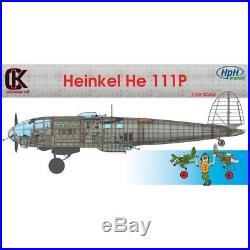
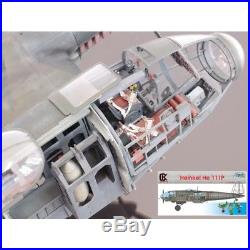
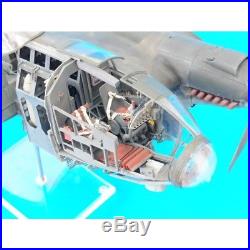
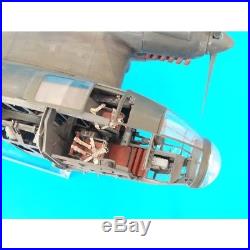
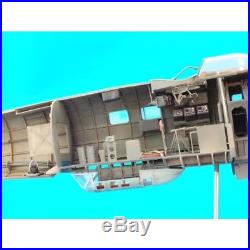

Heinkel He 111P 1/32 Scale Resin Kit Sectioned Aircraft. Heinkel He 111P (Internals) 1:32 Scale resin kit sectioned Aircraft. This Interiour Kit is designed to be used with the Revell Kit 1:32 HE 111p Fuselage. The Heinkel He 111 was a German aircraft designed by Siegfried and Walter Günter at Heinkel Flugzeugwerke in 1934.
Through development it was described as a "wolf in sheep's clothing" because the project masqueraded the machine as civilian transport, though from conception the Heinkel was intended to provide the nascent Luftwaffe with a fast medium bomber. The He 111P incorporated the updated Daimler-Benz DB 601A-1 liquid-cooled engine and featured a newly designed nose section, including an asymmetric mounting for an MG 15 machine gun that replaced the'stepped' cockpit with a roomier and more aerodynamic glazed stepless cockpit over the entire front of the aircraft.This smooth glazed nose was first tested on the He 111 V8 in January 1938. These improvements allowed the aircraft to reach 475 km/h (295 mph) at 5,000 m (16,400 ft) and a cruise speed of 370 km/h (230 mph), although a full bomb load reduced this figure to 300 km/h (190 mph). The design was implemented in 1937 because pilot reports indicated problems with visibility. The pilot's seat could actually be elevated, with the pilot's eyes above the level of the upper glazing, complete with a small pivoted windscreen panel, to get the pilot's head above the level of the top of the "glass tunnel" for a better forward view for takeoffs and landings.
The rear-facing dorsal gun position, enclosed with a sliding, near-clear view canopy, and for the first time, the ventral Bodenlafette rear-facing gun position, immediately aft of the bomb bay, that replaced the draggy "dustbin" retractable emplacement became standard, having been first flown on the He 111 V23, bearing civil registration D-ACBH. Primary parts and details made of resin.
Building instructions on a CD. Its a cottage industry compared to the big brands. This is because Companies that make Resin Kits usually concentrate on subjects not made by the main model companies. Resin Kits often contain extra detail like Metal Etch Parts and sometimes metal Undercarriage.
So if you want something different go for a Resin Model. As building resin kits is seen to be a "Black Art" by some modellers, we offer the following advice guide: From CMR. 1 - Study the instructions and familiarise yourself with the parts before starting to work in a methodical manner, as resin kits do not have individual part numbers. 2 - Wash the parts thoroughly with detergent before any assembly or painting.This is to remove mould release agent left over from the manufacturing process. 3 - Carefully remove the parts from the pouring blocks using a razor saw - or scalpel for small items - and clean them up before starting construction. Resin can be sanded easily and scribed like styrene to restore over-sanded panel lines, although scribing is best accomplished with a very sharp scriber and light strokes. Note: a certain amount of "Flash" is normal on resin kits due to the manufacturing processes involved, but this is easily removed. 4 - Test-fit everything to check for a decent fit before committing to glue.
Some shrinkage is normal for resin parts due to the batch variances in resin used and temperature. 5 - Warped parts are not that unusual in resin kits and can easily be corrected by gently heating the part with a hairdryer or by running it under a lukewarm tap before easing it back into shape. 6 - Use 5-minute Epoxy for large joins.Cyanoacrylate adhesive is more suitable for smaller joins. 7 - Gaps can be filled using "Superglue" Gel such as Pro-Bond No. 3 Slow Set/Gap Filling cyanoacrylate or normal model filler (such as Milliput epoxy putty). When using normal model filler it is possible to use a cotton bud lightly coated in Acetone (nail varnish remover) or Cellulose thinners to clean up the join as, unlike polystyrene, resin does not melt when in contact with cellulose thinners.
8 - Use a resin primer such as Mr. Resin Primer Surfacer" (by Gunze Sangyo) as this will reveal any "Pinholes left by air bubbles as a result of the manufacturing process - it also provides a key for the final paint finish to adhere to. 9 - Pinholes can be filled using drops of primer, superglue or even correction fluid (such as Tippex). 11 - Resin kits can be painted with normal model paints i. Enamel or Acrylic paints such as: Gunze Sangyo, Humbrol, Model Master, Revell, Tamiya, etc.
12 - Vac-form canopies are normally supplied in pairs. Glues (such as Krystal Klear) are best for affixing to the model - applied by small brush; any excess can be removed with a damp cloth before it has cured. However by first dipping the canopies in Johnson's "Future", not only does this improve the transparency of the canopy material, but it also prevents Cyanoacrylate (Superglue) from fogging them.
Note: Cyanoacrylates should not be used directly on untreated acetate canopies, as a white'blooming' may occur due to the adhesive reacting on contact with the transparency material. 13 - Decals supplied with our models do not require the use of solvents during their application. 14 - Many of our newer models now include Photo-Etch Detailing Sets. PE parts are best glued with cyanoacrylate (superglue). The item "Heinkel He 111P 1/32 Scale Resin Kit Sectioned Aircraft" is in sale since Tuesday, March 21, 2017.This item is in the category "Toys & Games\Model Kits\Models". The seller is "jhmcloughlin" and is located in Newbridge.
This item can be shipped worldwide.
- MPN: JPHPH32024I
- Brand: HPH Models
